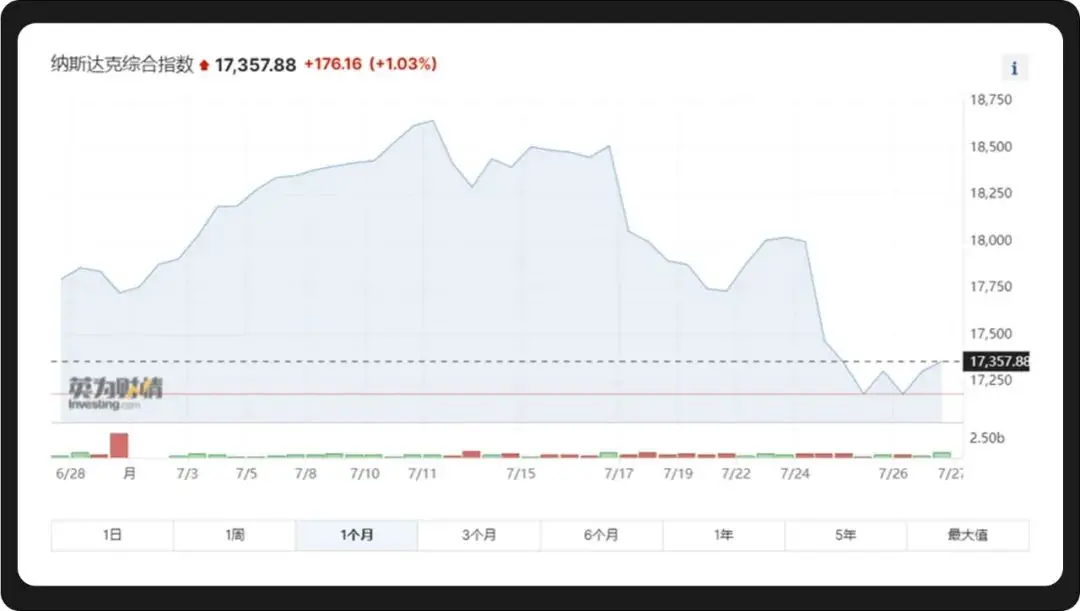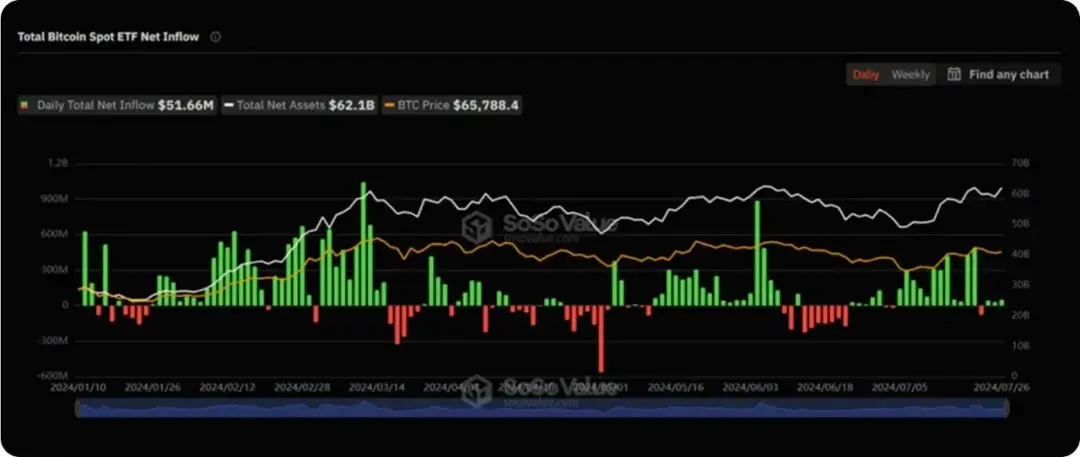WealthBee Macro Monthly Report: Countdown to US Rate Cuts May Begin, Ethereum Celebrates Its 10th Anniversary with Spot ETF Listing, Market Sentiment in a Spiraling Recovery

The newly released economic data from the U.S. in July has dispelled market concerns, with the market currently betting on a staggering 100% probability of a rate cut in September; U.S. stocks are undergoing a style shift as expected, with the big tech stocks' rally collapsing and small-cap stocks and non-tech sectors experiencing a resurgence; the crypto market in July was swept by emotions, but it has now stabilized; the Ethereum spot ETF has begun trading, and Grayscale's selling pressure has temporarily affected prices, but the selling speed is rapid, so the pressure may not last long.

On July 25, the U.S. announced a 2.8% quarter-on-quarter annualized growth in GDP for the second quarter of 2024, exceeding expectations of 2.0% (the first quarter was 1.4%). The PCE price index grew by 2.6% in the second quarter, down from 3.4% in the first quarter. The core PCE price index, which excludes food and energy prices and is the inflation indicator most closely watched by the Federal Reserve, grew by 2.9%, also lower than the previous value of 3.7%. However, the market seems skeptical about this data. On the day the data was released, U.S. stocks experienced significant volatility, opening high, then plummeting, being pulled back up, and then falling again, with both bulls and bears fiercely battling throughout the day, and the market unable to reach a consensus.
In fact, a considerable number of investors believe that the economic data provided by relevant U.S. agencies is "not real," as evidenced by the revisions to non-farm payroll data— the U.S. Department of Labor announced earlier this month that the non-farm payroll data for this month was 206,000 (expected 190,000), but at the same time, it significantly revised the April non-farm payroll increase from 165,000 down to 108,000, and the May non-farm payroll increase from 272,000 down to 218,000. After revisions, the total increase in employment for April and May was reduced by 111,000 compared to before the revisions. Statistics show that in the past five months, four months of employment figures have been revised down. This practice has evidently sparked various speculations and even doubts in the market, with many believing that economic data is merely a tool for the U.S. government to manipulate policy.
The prolonged interest rate hikes have already had a significant impact on the U.S. economy, and the market is now speculating that many economic data points are being "hyped" by the Federal Reserve and relevant U.S. government departments to create a rationale for rate cuts. Of course, the effect has been very effective: the current FedWatch Tool shows a 0% probability of maintaining the current interest rate level in September, in other words, the probability of starting rate cuts in September is 100%!

The emergence of such an extreme situation only indicates that the market has begun to make consistent pricing adjustments across all assets. The yield on the U.S. 10-year Treasury bond has entered a downward channel, with funds shifting from the risk-averse sentiment of the rate hike cycle to pricing various assets in the rate cut cycle.


First, let's take a look at the performance changes of the Russell 2000 small-cap index (RUT) and the Nasdaq Composite Index (IXIC) over the past month. These two indices are quite interesting: July 11 was the peak day for IXIC, but it was also the time when RUT took off.


July 11 was precisely the day the U.S. released the latest CPI data, and the market quickly picked up on the signals of easing inflation, with everyone agreeing that rate cuts could begin in September. Consequently, funds rapidly withdrew from large-cap stocks, leading to a collapse of the rally, and began to flow into small-cap stocks. WealthBee pointed out in its May Monthly Report that during the rate hike cycle, funds flowed into leading companies in the AI industry, and as the rate cut cycle approaches, the market's risk appetite will change first, at which point U.S. stocks may experience a style shift. During the rate cut cycle, abundant liquidity will increase the market's "speculative" nature. Compared to large-cap stocks, small-cap stocks have higher volatility, making them more suitable for speculation. Therefore, this "big to small" style shift is also reasonable.
Additionally, among the "Magnificent 7" of U.S. stocks—Apple (AAPL), Microsoft (MSFT), Alphabet (GOOG), Tesla (TSLA), Nvidia (NVDA), Amazon (AMZN), and Meta Platforms (META)—Tesla and Alphabet have already released their Q2 earnings reports. Tesla's operating profit for the second quarter was $1.605 billion, a 33% year-on-year decline, with market expectations at $1.81 billion; the adjusted earnings per share were $0.52, lower than the market expectation of $0.60. Alphabet's earnings report was relatively better, with total revenue for the second quarter at $84.742 billion, a 14% increase compared to $74.604 billion in the same period last year; net profit was $23.619 billion, a 29% increase compared to $18.368 billion in the same period last year; diluted earnings per share were $1.89, an increase from $1.44 in the same period last year. All these figures exceeded market expectations, but YouTube's advertising revenue did not meet expectations. The overall situation of these two companies is not very ideal, which has intensified market skepticism about the overall profitability of the Magnificent 7, and the market is also waiting for Apple's Q2 report on August 1.
In the AI narrative, if only Nvidia benefits while the other six companies in the Magnificent 7 fail to show sustained performance, it may struggle to support the market, and combined with the style shift, U.S. stocks may face more corrections. Observing the subsequent performance of Apple, Microsoft, and Nvidia, if they can exceed expectations, coupled with the overall liquidity brought by rate cuts, the beta returns of U.S. stocks may continue.

In July, due to the compensation from the Mt. Gox case, selling pressure from the German government, and Trump's speech at BitCoin 2024, the market experienced significant volatility—Bitcoin's price fell below $54,000 at its lowest, then broke through $70,000, and later fell back to around $66,000 by the end of the month. Recently, the Bitcoin volatility index reached a high peak level, indicating that the market is currently in a stage where both bulls and bears are evenly matched.

The Mt. Gox incident had already been anticipated by the market, and the German government's selling pressure was not substantial (about 1,000 coins per day), which theoretically would not have a significant impact on the secondary market. Therefore, the sharp drop at the beginning of the month was more of an emotional sell-off.

Trump, known as the "crypto-friendly president," emphasized in his late July speech at BitCoin 2024 that "the U.S. will become the world's Bitcoin center," even stating "I will not sell a single Bitcoin" and "the U.S. will establish a Bitcoin national reserve," seemingly trying to inject new confidence into the market. During his speech, Bitcoin's price first plummeted by $1,200, falling below $67,000, and then quickly rebounded, ultimately soaring to a high of $69,000. However, after Trump's speech ended, Bitcoin's price fell again, reflecting the market's divergence on the feasibility of Trump's statements and their long-term market impact. Perhaps the market has also overestimated the probability of Trump being elected president; currently, his Republican competitor Harris is not weak, and with multiple politically correct advantages, she also enjoys a high approval rating, while her stance on cryptocurrencies remains ambiguous.
While Bitcoin's volatility has sparked heated discussions, the Ethereum market also welcomed its milestone moment this month: on July 23, coinciding with the tenth anniversary of Ethereum's first public sale, the Ethereum spot ETF began trading. However, market performance has been quite lackluster: Farside Investors data shows that over $100 million net inflow occurred on the first day of trading, but there was a continuous net outflow in the following days.

From the table, we can see that Grayscale's products have been experiencing significant outflows, reminiscent of the scenario when the Bitcoin spot ETF was launched: at that time, Grayscale was also selling off a large amount of Bitcoin. Grayscale will convert its existing Grayscale Ethereum Trust (ETHE) into an ETF, maintaining the previous fee rate of 2.5%. This high fee far exceeds that of other competitors, which will inevitably lead to significant selling by investors, either cashing out or switching to competitors' products.
However, there is no need to worry too much about this situation. Currently, the selling speed of Grayscale's ETFE is very fast. When ETHE was listed, Grayscale held about 2.63 million Ethereum, worth approximately $9 billion. As of the 26th, $1.5 billion has already flowed out, and such a rate of outflow will quickly reduce selling pressure. The pain is only temporary; the rapid launch of the Ethereum spot ETF has already proven that crypto assets are being accepted by traditional markets at an unexpected speed, and the future of crypto assets is bound to be bright.
Overall, the entire market in July was almost dominated by emotions. Perhaps the crypto market currently lacks a new narrative for a bull market, combined with its decoupling from the performance of U.S. stocks, is in a relatively chaotic period, making it more susceptible to emotional influences.
However, it appears that the market has fully digested the emotions and is showing a spiraling upward recovery trend, with Bitcoin's price moving in the right direction. The Bitcoin spot ETF is also experiencing continuous net inflows, reflecting that market panic has not persisted, signaling the arrival of a larger market trend.


Despite uncertainties in the macro economy and traditional financial markets, the crypto asset market demonstrates its independence and resilience, likely playing an increasingly important role in diversified investment portfolios and providing new growth opportunities for investors. This month, Bitcoin's price exhibited a "roller coaster" trend, largely driven by emotions, while the long-term trend represented by the Bitcoin spot ETF remains unchanged. The launch of the Ethereum spot ETF has also brought new vitality and stability to the market. The future of the crypto market is full of challenges, but also full of hope.










